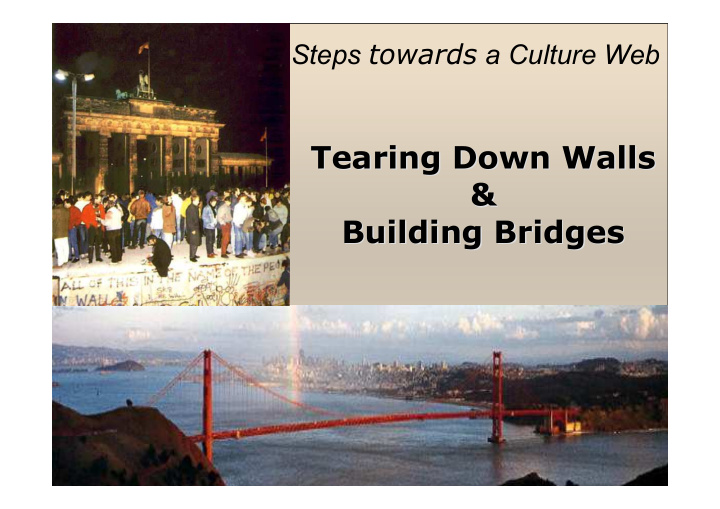



Steps towards a Culture Web Tearing Down Walls Tearing Down Walls & & Building Bridges Building Bridges
Interoperability: tearing down the walls between collections • Musea have increasingly nice websites • But: most of them are driven by stand-alone collection databases • Data is isolated, both syntactically and semantically • If users can do cross-collection search, the individual collections become more valuable ! 2
The Web: “open” documents and links URL URL Web link 3
The Semantic Web: “open” data and links Painting Painter “Green Stripe (M me Matisse)” “Henri Matisse” Royal Museum of Fine Arts, Copenhagen Getty ULAN creator Dublin Core URL URL Web link 4
5
Levels of interoperability • Syntactic interoperability – using data formats that you can share – XML family is the preferred option • Semantic interoperability – How to share meaning / concepts – Technology for finding and representing semantic links 6
7
Multi-lingual labels for concepts 8
9
Principle 1: semantic annotation • Description of web objects with “concepts” from a shared vocabulary 10
Principle 2: semantic search Query • Search for “Paris” objects which are linked via Paris concepts (semantic link) PartOf • Use the type of semantic link to provide Montmartre meaningful presentation of the search results 11
Term disambiguation is key issue in semantic search • Post-query – Sort search results based on different meanings of the search term – Mimics Google-type search • Pre-query – Ask user to disambiguate by displaying list of possible meanings – Interface is more complex, but more search functionality can be offered 12
Principle 3: vocabulary alignment “Tokugawa” AAT style/period SVCN period Edo (Japanese period) Edo Tokugawa SVCN is local in-house AAT is Getty’s ethnology thesaurus Art & Architecture Thesaurus 13
The myth of a unified vocabulary • In large virtual collections there are always multiple vocabularies – In multiple languages • Every vocabulary has its own perspective – You can’t just merge them • But you can use vocabularies jointly by defining a limited set of links – “Vocabulary alignment” • It is surprising what you can do with just a few links 14
Learning alignments • Learning relations between art styles in AAT and artists in ULAN through NLP of art historic texts – “Who are Impressionist painters?” 15
From metadata to semantic metadata 16
Example textual annotation 17
Resulting semantic annotation (rendered as HTML with RDFa) 18
Perspectives • Basic Semantic Web technology is ready for deployment • Web 2.0 facilities fit well: – Involving community experts in annotation – Personalization, myArt • Social barriers have to be overcome! – “open door” policy – Involvement of general public => issues of “quality” 19
Caveats for museum software • Be wary of Flash – Accessibility • Make sure you can connect others and other can connect to you – “Don’t buy software which does not support standard open API’s” • Export facilities to common formats (XML, …) 20
http://e-culture.multimedian.nl • Part of the Dutch knowledge-economy project MultimediaN • Partners: VU, CWI, UvA, DEN, ICN • People: Alia Amin, Lora Aroyo, Mark van Assem, Victor de Boer, Lynda Hardman, Michiel Hildebrand, Laura Hollink, Marco de Niet, Borys Omelayenko, Marie-France van Orsouw, Jacco van Ossenbruggen, Guus Schreiber Jos Taekema, Annemiek Teesing, Anna Tordai, Jan Wielemaker, Bob Wielinga • Artchive.com, Rijksmuseum Amsterdam, Dutch ethnology musea (Amsterdam, Leiden), National Library (Bibliopolis) 21
Recommend
More recommend